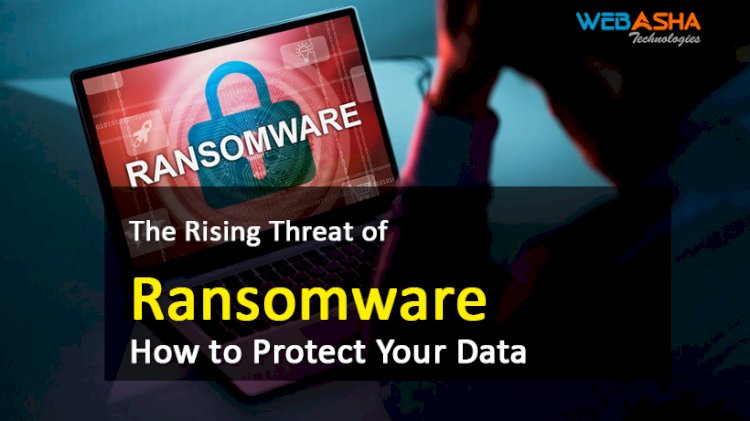The Rising Threat of Ransomware | How to Protect Your Data from Ransomware
Learn how to defend against the rising threat of ransomware and protect your valuable data. Discover strategies to prevent attacks, secure your systems, and develop a robust response plan in case of an incident.

In an increasingly digital world, where data powers our lives, the specter of ransomware looms larger than ever before. Ransomware attacks have escalated into a global crisis, affecting individuals, businesses, and even critical infrastructure. This comprehensive guide delves into the alarming rise of ransomware threats, the mechanisms behind these attacks, and most importantly, equips you with proactive strategies to safeguard your invaluable data.
Introduction: The Menace of Ransomware
Imagine waking up to find your computer files, photographs, and work documents encrypted and held hostage by cybercriminals. This is the grim reality of ransomware attacks, where malicious actors exploit vulnerabilities to encrypt data, demanding a hefty ransom in exchange for its release.
The Evolution of Ransomware: From Nuisance to Catastrophe
Ransomware has evolved from a mere nuisance to a lucrative criminal enterprise. Early iterations of ransomware were relatively simple, but today's variants are sophisticated and capable of crippling entire organizations. The infamous WannaCry and NotPetya attacks serve as stark reminders of the widespread devastation ransomware can wreak.
How Ransomware Works: Unveiling the Mechanics
Ransomware typically infiltrates systems through phishing emails, malicious downloads, or exploiting software vulnerabilities. Once inside, it encrypts files using strong encryption algorithms, rendering them inaccessible. The victim is then presented with a ransom note, demanding payment in cryptocurrency to decrypt the files.
The Cost of Ransom: Beyond the Monetary
The financial toll of ransom payments can be staggering, but the costs extend beyond mere monetary transactions. Ransomware attacks can lead to data loss, operational downtime, reputational damage, and legal ramifications. Critical infrastructure, healthcare institutions, and small businesses are particularly vulnerable.
Protecting Your Data: A Multi-Layered Approach
The key to defending against ransomware lies in a multi-layered approach that addresses both prevention and recovery. Here are actionable steps to fortify your defenses:
1. Regular Data Backups: Your Digital Insurance Policy
Backing up your data regularly is paramount. Create secure offline backups that are isolated from your network. This ensures you can restore your data without succumbing to ransom demands.
2. Robust Security Software: Fortify Your Perimeter
Employ reputable antivirus and anti-malware software that offers real-time protection against malicious files and links. Regularly update your security software to stay ahead of emerging threats.
3. Software Updates: Closing the Door to Vulnerabilities
Outdated software can be a gateway for ransomware. Regularly update your operating system, applications, and plugins to patch vulnerabilities that attackers exploit.
4. Employee Training and Awareness: Your Human Firewall
Educate employees about phishing techniques and safe online practices. Conduct regular training sessions to empower them to identify and report suspicious emails or links.
5. Email Hygiene: Filter Out Threats
Implement advanced email filtering to weed out phishing emails and malicious attachments before they reach your inbox.
6. Network Segmentation: Containing the Threat
Segment your network to limit the lateral movement of ransomware. This prevents an infection in one part of the network from spreading to others.
7. Restrict User Privileges: Limiting the Impact
Grant users the minimum level of access necessary to perform their tasks. This minimizes the potential impact of a ransomware attack.
8. Incident Response Plan: Being Prepared
Develop a robust incident response plan that outlines the steps to take in case of a ransomware attack. Test the plan periodically to ensure its effectiveness.
9. Zero Trust Architecture: Verify Everything
Adopt a zero-trust approach, where users and devices are not automatically trusted, regardless of their location. Every access request is rigorously verified.
10. Seek Professional Help: When in Doubt
If your organization falls victim to a ransomware attack, involve cybersecurity experts and law enforcement. Attempting to negotiate with attackers can be risky and counterproductive.
Conclusion: A Secure Digital Future
Ransomware poses a formidable threat that demands immediate action. By understanding its mechanics and embracing a comprehensive cybersecurity strategy, you can significantly reduce your vulnerability. Remember, the best defense is a proactive one. Prioritize cybersecurity, educate your team, and invest in technologies that shield your data from the clutches of ransomware criminals.
As technology evolves, so do the tactics of cybercriminals. However, armed with knowledge, vigilance, and a resilient cybersecurity stance, you can navigate the digital landscape with confidence, ensuring the safety of your data and the continuity of your digital endeavors.











![Top 10 Ethical Hackers in the World [2025]](https://www.webasha.com/blog/uploads/images/202408/image_100x75_66c2f983c207b.webp)



![[2025] Top 100+ VAPT Interview Questions and Answers](https://www.webasha.com/blog/uploads/images/image_100x75_6512b1e4b64f7.jpg)







